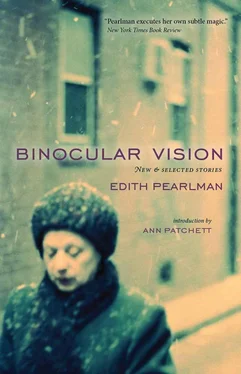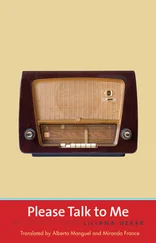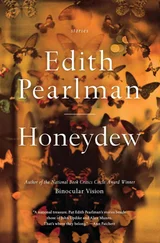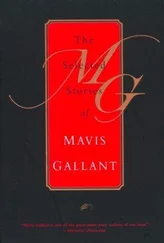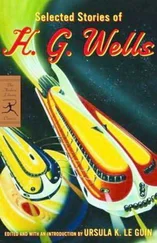Edith Pearlman - Binocular Vision - New & Selected Stories
Здесь есть возможность читать онлайн «Edith Pearlman - Binocular Vision - New & Selected Stories» весь текст электронной книги совершенно бесплатно (целиком полную версию без сокращений). В некоторых случаях можно слушать аудио, скачать через торрент в формате fb2 и присутствует краткое содержание. Год выпуска: 2011, Издательство: Lookout Books, Жанр: Современная проза, на английском языке. Описание произведения, (предисловие) а так же отзывы посетителей доступны на портале библиотеки ЛибКат.
- Название:Binocular Vision: New & Selected Stories
- Автор:
- Издательство:Lookout Books
- Жанр:
- Год:2011
- ISBN:нет данных
- Рейтинг книги:5 / 5. Голосов: 1
-
Избранное:Добавить в избранное
- Отзывы:
-
Ваша оценка:
- 100
- 1
- 2
- 3
- 4
- 5
Binocular Vision: New & Selected Stories: краткое содержание, описание и аннотация
Предлагаем к чтению аннотацию, описание, краткое содержание или предисловие (зависит от того, что написал сам автор книги «Binocular Vision: New & Selected Stories»). Если вы не нашли необходимую информацию о книге — напишите в комментариях, мы постараемся отыскать её.
Binocular Vision: New & Selected Stories — читать онлайн бесплатно полную книгу (весь текст) целиком
Ниже представлен текст книги, разбитый по страницам. Система сохранения места последней прочитанной страницы, позволяет с удобством читать онлайн бесплатно книгу «Binocular Vision: New & Selected Stories», без необходимости каждый раз заново искать на чём Вы остановились. Поставьте закладку, и сможете в любой момент перейти на страницу, на которой закончили чтение.
Интервал:
Закладка:
How are you, Eleanor? I’ve got an Edwardian inkwell you might want to take a look at.
Rennie
February 15
Dear Ms. Jenkins,
Thank you for granting me an extension for my Jan Term paper. I didn’t need as much time as I first thought. Per your suggestion, I had kept daily notes on three-by-five cards, and as you predicted, it was not onerous to, after reading over the cards several times and arranging and rearranging them as if playing FreeCell* and thinking about them deeply, make an outline. (The preceding sentence demonstrates why you should not split an infinitive, so I left it in rather than correct it in case you need a reality example for the tenth-grade grammar unit.) My outline followed the helpful schema you provided: Why I Chose, What I Did, Some Things I Learned. After constructing the outline, writing the essay was pretty straightforward. I made the required three drafts on three successive days, starting on the morning my father gave me a typewriter (our computer had met with an accident). I found footnotes useful and deployed them according to The Chicago Manual of Style, numbering sequentially.
And so here is my paper, which I dedicate to my late mother. As you may know, though it was before your time, she too attended Caldicott Academy. She often shared with me her school-day memories, though she called them flashbacks. LOL.
Josie
* Similar to Solitaire
FORGET ME NOT JANUARY TERM PAPER JOSEPHINE DOROTHY SALTER
My original plan for a Jan Term project was to read to the blind. I’m told that I have a pleasing voice. Before she died of a tumor 1my mother lost her vision, and so I read to her every afternoon just as she had read to me when I was little, mostly Grimm’s Fairy Tales, our favorite book. But readers to the blind are sent all over the Boston area, hither and yon, and I needed a workplace close to my stepbrother Tollie’s day care center, since his own mother was not at home at the time and therefore I was in charge of him and also of our household, which numbered three. So I applied to Forget Me Not, a nearby antique shop, because you can learn a lot of history from the artifacts of the past. Ms. Renata McLintock, owner and proprietor, warned me that what I would learn mostly was cleaning and a steady hand in pouring liquids, and she hoped that my progressive, prolapsed 2school had taught me how to compute the 5 percent Massachusetts sales tax and that I would remember to do so. 3
In this paper I will refer to Ms. McLintock as “Rennie,” since she asked me to call her that. She doesn’t know where her mother dug up Renata. 4Rennie was right about what I would mainly do. I vacuumed the floor and the furniture (I did that at home in January, too) and I scrubbed the little bathroom in back and then dumped the contents of the pail into the window boxes, for which I was responsible. 5I climbed a ladder and polished the brass chandelier which dates from 1775 or thereabouts. It has been wired and fitted with 60-watt bulbs.
Those were my computational and cleaning duties. Some were daily and some were weekly. Also I assisted Rennie at hostessing tasks. Forget Me Not is like the village well of colonial times, a period we studied last year. At the village well, news and gossip and advice were exchanged. Women went away from it with water and also with strength and self-esteem, though some did find pleasure in making others feel wrong or stupid. But of this unpleasant type there were only a few at Forget Me Not. I will mention a particular person later. Also we have many customers who come in just to chat and don’t buy anything. Some want a smattering of comfort, like the one whose daughter had gotten rolled over by Princeton, 6and others want a lot of solace, like the woman whose son had just died. 7I became able to tell the difference between the two and to make tea for the first type and for the second type to pour sherry without spilling any.
This takes me to the main part of my paper: What I Learned at Forget Me Not in addition to techniques of polishing metal and how to wheedle the credit card machine into working. I learned the distinguishing features of various jewelry styles: Victorian, art nouveau, art deco, and post — World War II until about 1950 (Rennie doesn’t carry anything later than 1950). Victorian is delicate and elaborate. Art nouveau is inspired by natural and mythological themes like dragonflies or enchanted women, set in sinuous designs. Art deco is geometric and employs motifs like ziggurats and lozenges. World War II introduced synthetic materials, and Rennie has some Bakelite slave bracelets that look like butterscotch silk. All this jewelry and estate silver and Chinese ceramics are the store’s bread and butter. Rennie’s particular specialties are pottery made by the Saturday Evening Girls and Victorian mourning jewelry.
The Saturday Evening Girls grew out of the arts and crafts movement in England of the 1870s, based on the reformist ideals of John Ruskin and William Morris. Those two important men advocated a return to hand craftsmanship, not just for aesthetic quality but also for the purpose of furthering social and educational goals. 8At the turn of the nineteenth century, in Boston’s crowded North End, just a few miles from Forget Me Not, a group of young Italian and Jewish immigrant women gathered on Saturday nights to make ceramics, guided by an altruistic socialite. 9She wanted the Girls to earn money and also work in a healthy and uplifting environment. But people didn’t buy the pottery, because its prices were higher than mass-produced wares. Now the dishes are prized and collectors pay a lot of money for them, often to Rennie. The pottery is simple and colorful and sometimes decorated with barnyard motifs; if you didn’t know it was urban, you might call it rustic. Either way it is pretty — Rennie and I both think so.
Victorian mourning jewelry is a horse from a different glue factory. 10Rennie and I don’t much care for it but it is all the rage today, and a few Goth girls of my acquaintance (not Caldicott students) wear gutta-percha hair ornaments decorated with death’s heads. Mourning jewelry was meant to be a souvenir to remember a loved one and also a reminder of the inevitability of death. Mourning rings reached the height of popularity in England after the death of Prince Albert, in December 1869. 11In England, rings were often inscribed with the name, age, and date of death of the lost person. Early rings were made of black enamel. Later ones were jet.
Since this is a research and observation paper, I have mostly kept anecdotes and speculations and digressions out of it or tucked them into footnotes that a reader can skip. Anyway, I am taking Journal Writing next semester. I did observe the operational details of a small retail business, so I will report on that. Rennie let me look at her ledger, which is of the pen-and-ink variety. Her accountant urged her to get a computer but finally said “Oh hell.” 12In Rennie’s handwriting, each letter and number slants at a 60-degree angle to the line. It’s more legible than many fonts. 13Rennie also took me with her on a few house calls. I saw how shrewd you have to be at sizing up the worth of individual items and also entire roomfuls of stuff. In one huge mansion the owner had just died 14and there was wonderful silver, as you would expect. But in a couple of awful apartments, Rennie found some unusual objets d’art. She always paid what they were worth, though of course not as much as she hoped to sell them for.
I also observed and attempted to emulate her various ways of dealing with customers beyond serving tea and/or sherry to the obviously unhappy ones. She shows patience to people who can’t make up their minds and also to those who need to think it over, which really means ask their husbands. She is firm with dealers who want a deep discount. She allows returns always. She puts up with a lot but doesn’t put up with everything. For instance, that unlikable woman referred to earlier came in frequently just to gab. The woman usually didn’t pay attention to me, but one day when Rennie was finishing up with somebody else she asked me to show her a jet mourning ring. I did, and told her that the finest jet was mined in Whitby, England. Whitby got used too much, and today it is illegal to mine there because the only jet left is in seams in the cliffs over the town. To remove it from the cliffs would cause them to tumble down. In this case, overmining led to undermining. In the middle of my mini-lecture, which I had practiced on other customers with good results (i.e., sales), she said, too sincerely, You have a beautiful voice. Then she said, Who are you? and I told her my name, first, middle, last. She said Salter I know your family your mother was a saint your stepmother is a slattern your father is a tyrant. Like that, with no punctuation. I’m surprised she didn’t say your brother is on the spectrum. Rennie hustled her out in thirty seconds, maybe less, mentioning untruthfully that we were going on a house call, and she actually turned on the alarm and locked the door with the three of us outside it for verisimilitude. We watched the woman go away. 15Then we went next door to the deli and had lunch, which Rennie paid for (usually I bring a Tupperware container of last night’s meat loaf, or macaroni with a little lettuce from the night before that, or creamed chipped beef from even earlier if it hasn’t gone bad). Over lunch Rennie gave me a recipe for All-Week-Long minestrone, a vegetable soup that lasts from Sunday through Saturday. I would have made it on the weekend but Tina came home and we went back to takeout, which Tollie prefers anyway. It was that lunchtime that I told Rennie that Tollie’s breakfast every day is a scoop of vanilla ice cream and half a cup of coffee. He won’t eat anything else. Very few people would have refrained from comment, but Rennie just nodded. Very few people have the discreetness to run a village well. I hope I can attain that quality, as I am thinking of the antique business as a career.
Читать дальшеИнтервал:
Закладка:
Похожие книги на «Binocular Vision: New & Selected Stories»
Представляем Вашему вниманию похожие книги на «Binocular Vision: New & Selected Stories» списком для выбора. Мы отобрали схожую по названию и смыслу литературу в надежде предоставить читателям больше вариантов отыскать новые, интересные, ещё непрочитанные произведения.
Обсуждение, отзывы о книге «Binocular Vision: New & Selected Stories» и просто собственные мнения читателей. Оставьте ваши комментарии, напишите, что Вы думаете о произведении, его смысле или главных героях. Укажите что конкретно понравилось, а что нет, и почему Вы так считаете.
